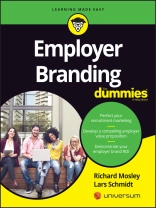Attract the very best talent with a compelling employer brand!
Employer Branding For Dummies is the clear, no-nonsense guide to attracting and retaining top talent. Written by two of the most recognized leaders in employer brand, Richard Mosley and Lars Schmidt, this book gives you actionable advice and expert insight you need to build, scale, and measure a compelling brand. You’ll learn how to research what makes your company stand out, the best ways to reach the people you need, and how to convince those people that your company is the ideal place to exercise and develop their skills. The book includes ways to identify the specific traits of your company that aligns with specific talent, and how to translate those traits into employer brand tactic that help you draw the right talent, while repelling the wrong ones. You’ll learn how to build and maintain your own distinctive, credible employer brand; and develop a set of relevant, informative success metrics to help you measure ROI. This book shows you how to discover and develop your employer brand to draw the quality talent you need.
- Perfect your recruitment marketing
- Develop a compelling employer value proposition (EVP)
- Demonstrate your employer brand ROI
Mục lục
Introduction 1
About This Book 1
Foolish Assumptions 2
Icons Used in This Book 3
Beyond the Book 3
Where to Go from Here 3
Part 1: Getting Started with Employer Branding 5
Chapter 1: Building a Strong Employer Brand 7
What Is Employer Branding? 8
Recognizing the benefits of employer branding 8
Stepping through the employer branding process/cycle 9
Laying the Foundation for Your Employer Brand 11
Aligning with business goals and objectives 11
Fitting in with your other brands 12
Rallying the troops (and leaders) 12
Taking an Honest Look at Your Employer Brand 13
Putting the Pieces in Place 14
Defining the give and get of the employment deal 15
Establishing employer brand guidelines 16
Giving your target talent a reason to tune in 17
Spreading the Word through Various Channels 19
Staying True to the Promise of Your Employer Brand 20
Monitoring Your Employer Branding Success 21
Chapter 2: Preparing for the Journey 23
Finding Your Fit within the Overall Company Strategy 24
Aligning with the corporate brand 25
Aligning with the customer brand 27
Supporting the business strategy 29
Getting the right talent onboard 29
Aligning with human resources 34
Building Your Business Case for Employer Branding 34
Considering cost-cutting benefits 35
Checking out possible performance benefits 36
Making Friends and Influencing People 38
Getting senior leadership onboard 38
Convincing marketing and communications to go along with the idea 39
Getting HR comfortable with the language and thinking of brand management 40
Chapter 3: Conducting an Employer Brand Health Check 41
Taking a Look in the Mirror 42
Finding out what you already know 42
Conducting employee surveys and focus groups 43
Taking a Look from the Outside In 47
Gauging employer brand awareness, consideration, and preference 47
Identifying your key talent competitors 49
Evaluating the strength of your organization’s employer brand image 50
Evaluating the factors that shape your organization’s brand image 53
Weighing Your Competition 54
Benchmarking your competitors’ media presence 55
Mapping your competitors’ brand positioning 56
Spotting generic plays and opportunities to be different 57
Part 2: Developing an Effective Employer Brand Strategy 61
Chapter 4: Defining Your Employer Value Proposition 63
Setting Your Sights on the Goal: A Sample Employer Value Proposition 64
Brainstorming to Generate Ideas and Content 66
Gathering the right people 67
Drawing insights from your data 67
Conducting a productive employer value proposition development workshop 69
Balancing Competing Perspectives 73
Clarifying the give and get of the employment deal 73
Weighing current strengths and future aspirations 74
Balancing global and local considerations 75
Differentiating Your Organization from the Competition 76
Choosing Your Core Positioning 77
Writing Your Employer Value Proposition 78
Sense Checking and Stress Testing 79
Identifying tangible claims and proof points 79
Field-testing your draft employer value proposition 80
Chapter 5: Building Your Employer Brand Framework 83
Aligning Your Employer Branding with Your Corporate and Customer Branding 84
Working with a monolithic brand 84
Navigating within a house of brands 86
Optimizing the parent-subsidiary house of brands framework 87
Creating a Visual Brand Identity with Impact 88
Developing Overarching Recruitment Campaigns 90
Setting campaign objectives 90
Writing a creative creative brief 91
Choosing the right creatives to work with 92
Testing Creative Solutions 95
Checking whether a creative solution works across different target groups 95
Choosing the best creative solutions 97
Chapter 6: Generating Engaging Content 101
Grasping the Need to Go Beyond Recruitment Advertising 102
Mastering the Principles of Content Marketing 103
Balancing immediate engagement with long-term brand building 104
Local engagement hooks 105
Exploring Different Ways to Pitch Your Story 105
Showcasing existing talent: Employee profiles and stories 106
Be bold: Cutting through the corporate speak 110
Delivering facts, figures, and infographics 112
Making the most of video 113
Gaming your system 114
Promoting Employee-Generated Content 114
Facilitating employee-generated content with the right technology 116
Developing policies to prevent misbehavior and mishaps 116
Managing Your Content 117
Assembling a content marketing and management team 117
Conducting a content audit 118
Tagging and categorizing content to facilitate indexing and raise its search engine ranking 119
Building a content marketing editorial calendar 119
Chapter 7: Rolling Out Your Employer Brand Strategy 121
Winning Internal Hearts and Minds 121
Briefing Managers before Engaging Employees 123
Briefing Key Management Stakeholders 124
Engaging leadership 124
Pitching your plan to the HR/talent community 125
Ensuring alignment with corporate communications and marketing 126
Briefing Your Recruitment Teams 127
Developing your employer brand toolkit 127
Creating content playbooks 128
Providing guidance on localization 129
Getting team managers onboard 130
Engaging Employees 132
Think: Taking a rational, measured approach 134
Feel: Nurturing emotional engagement 135
Do: Inspiring employee commitment and behavior change 136
Maintaining consistency and continuity 137
Part 3: Reaching Out through the Right Channels 139
Chapter 8: Constructing Your Recruitment Marketing Plan 141
Sizing Up Your Audience 142
Segmenting your audience 142
Prioritizing your audience segments 143
Creating talent personas 144
Evaluating Target Talent Media Preferences 146
Mapping out your media options 146
Reaching people on the move (mobile) 147
Connecting with active and passive job seekers 148
Setting Out Your Plan 149
Balancing inbound and outbound marketing activities 150
Putting a recruitment marketing system in place 151
Chapter 9: Creating a Winning Career Site 153
Making a Great First Impression 154
Checking off landing page essentials 154
Integrating with your social properties 155
Optimizing for mobile 157
Staying a step ahead of the Joneses 157
Delivering the Goods: Content 158
Aligning your website with your employer value proposition 159
Tailoring content to target groups 159
Writing effective job descriptions 160
Making it easy to apply 162
Personalizing your response letters 163
Creating Job Microsites 164
Chapter 10: Developing Your Talent Network 165
Leveraging the Networking Power of Current and Former Employees 166
Understanding why referrals make great hires 166
Setting up an employee referral program 167
Building an alumni talent network 171
Boosting Your Rejected Candidate Referral Rate 173
Creating Your Own Talent Communities 174
Chapter 11: Engaging Talent through Social Media 177
Getting Your Head in the Game 178
Where to show up: Choosing social channels 178
How to engage potential candidates 178
Laying the Groundwork 180
Choosing a social dashboard 180
Budgeting for ads and sponsored content 181
Making time for social media 181
Recruiting on Linked In 182
Building your Company and Career pages 182
Posting regular status updates 183
Measuring and optimizing engagement 183
Having employees update their profiles 184
Giving Job Seekers a Backstage Pass with Glassdoor 184
Making a Splash on Facebook 187
Creating a Facebook Page 187
Hosting Facebook Groups 189
Broadcasting via Facebook Live 189
Attracting Top Talent on Twitter 190
Picking up strategies by observing others 190
Using hashtags to source candidates 190
Engaging prospects 191
Getting your employees involved 192
Gauging your Twitter impact 192
Adapting to a New Model: Snapchat 192
Leveraging Video 193
Exploring ways to use video in recruitment marketing 194
Recognizing the importance of You Tube 194
Exploring Chat Platforms and Regional Channels 195
Building a Social Media Calendar 196
Chapter 12: Making the Most of Recruitment Advertising 199
Raising Your Employer Brand Profile in Search Engine Results 200
Using search engine optimization to improve your site’s search engine ranking 201
Gaining traction with search engine marketing 202
Sizing Up Paid Media Channels 203
Evaluating your potential media mix 204
Programmatic media buying 206
Getting the Best out of Job Boards 207
Adding a Personal Touch with Direct Engagement 208
Personalizing your message 208
Cutting through the spam 209
Chapter 13: Making a Splash on Campus 211
Marketing to College Students 212
Understanding the student/graduate mind-set 212
Attending to key touch points 213
Evaluating regional differences 215
Converting interns 215
Designing an attractive graduate program 216
Balancing targeting with diversity 217
Choosing Schools Wisely 218
Supporting College Career and Job Placement Services 219
Reaching Out to Less Prominent Institutions 220
Part 4: Delivering on Your Employer Brand Promises 223
Chapter 14: Shaping a Positive Brand Experience 225
Applying Customer Experience Thinking to HR Processes 226
Thinking differently about HR 226
Reviewing your current employment experience 227
Engaging in Touch-Point Planning 230
Conducting a touch-point review 230
Touch-point action planning 232
Designing signature experiences 233
Chapter 15: Making a Positive Impression on Candidates 237
Building Candidate-Friendly Application and Selection Processes 238
Designing a professional and courteous application and selection funnel 238
Tailoring your application, screening, and selection process to your EVP 242
Ensuring a Positive Brand Experience through Induction and Orientation 243
Focusing on the fundamentals 244
Preboarding new hires 246
Providing a warm welcome 247
Designing an extensive orientation process 248
Chapter 16: Engaging and Retaining Your Talent 249
Conducting Engagement Survey Action Planning 249
Considering the conventional approach to engagement action planning 250
Leading with your EVP 251
Leading from the top 254
Ongoing Engagement and Retention Processes 255
Conducting team briefings 255
Engaging in key people-management conversations 256
Identifying and responding to retention risks 257
Establishing an early-warning system 258
Maintaining Attraction and Engagement in the Midst of Organizational Change 260
Navigating a reorganization 260
Smoothing the transition during an acquisition 261
Rebranding a merger of equals 261
Part 5: Measuring the Success of Your Employer Branding Strategy 263
Chapter 17: Gauging Your Immediate Impact on Audience Engagement and Hiring 265
Linking Recruitment Marketing Activities to Objectives 266
Measuring the Effectiveness of Recruitment Advertising 267
Advertising costs 267
Audience exposure 268
Engagement 268
Source of application and source of hire 268
Analyzing the effectiveness of recruitment advertising 269
Measuring the Effectiveness of Social Campaigns 269
Social media costs 270
Audience exposure 270
Engagement 270
Source of application, source of hire, and source of influence 271
Using the results of your analysis to enhance your recruitment marketing 272
Measuring the Effectiveness of Career Site Content 272
Career site costs 273
Audience exposure 273
Engagement 274
Source of application and source of hire 274
Improving career site effectiveness through analysis 275
Measuring Referral Effectiveness 275
Referral costs 275
Audience exposure 276
Engagement 276
Source of application and source of hire 276
Improving referral effectiveness through analysis 277
Analyzing Your Overall Recruitment Marketing Strategy Success 277
Calculating cost-per-hire 278
Measuring success in terms of quality applicants and hires 279
Comparing your results to external benchmarks 280
Chapter 18: Monitoring and Maintaining Long-Term Impact on Employer Brand Value 281
Tracking Employer Brand Awareness and Reputation 282
Measuring improvements in brand awareness, consideration, and preference 282
Examining conversion ratios 285
Conducting employer brand image surveys 285
Drawing conclusions from external brand tracking 287
Tracking the Internal Impact of Your Employer Brand Strategy 289
Evaluating employee engagement 289
Tracking your employer brand experience 290
Evaluating the candidate experience 292
Assessing the onboarding experience 294
Evaluating employer branding’s impact on employee performance 294
Analyzing Your Employer Brand Index 296
Keeping Pace with Talent Market Trends 297
Part 6: The Part of Tens 301
Chapter 19: Ten Success Factors to Embrace 303
Getting Your Leadership Team’s Buy-In 303
Bridging the Gap between HR and Marketing 304
Sizing Up Your Company’s Talent Needs 305
Defining a Clear and Compelling Employer Value Proposition 305
Building Flexibility into the Framework 306
Getting Current Employees Onboard First 306
Making the Most of Social Media 307
Keeping an Eye on Your Competition 307
Getting into the Right Shape for Talent 308
Investing in Metrics 308
Chapter 20: Ten Common Mistakes to Avoid 311
Treating Employer Branding as a Project 311
Failing to Focus 312
Promising the Sun, the Moon, and the Stars 312
Playing It Too Safe: Corporate Bland or Industry Generic 313
Getting Obsessed with the Tagline 314
Over-Policing Your Local Teams 314
Underestimating the Resources Required to Create Quality Content 315
Forgetting to Connect Communication with Experience 315
Turning Off Your Brand Investment When the Going Gets Tough 316
Failing to Learn from Experience 317
Chapter 21: Ten Ways to Minimize Cost and Maximize Impact 319
Building More Talent Than You Buy 320
Maximizing Referrals 320
Hiring Above-Average Talent for an Average Wage 320
Targeting Efforts to Attract Fewer, But Higher-Quality Candidates 321
Focusing Your Creative Spend 321
Shifting from Paid to Owned and Earned Media 322
Localizing Content Creation 322
Encouraging Employee-Generated Content 323
Creating Your Own Talent Pools 323
Learning from Failure and Building on Success 324
Index 325
Giới thiệu về tác giả
Richard Mosley, Universum’s Global Head of Strategy, is widely recognized as a leading global authority on the subject of employer branding. He regularly chairs or delivers keynote presentations at many of the world’s leading employer brand events. Lars Schmidt, Founder of Amplify Talent and Cofounder of HR Open Source, is a leading strategy consultant, speaker, and writer in the fields of employer branding and recruiting.











